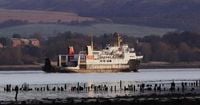The MV Hebridean Isles, a beloved CalMac ferry that has served Scotland’s island communities for decades, is finally embarking on her last journey—a voyage not across the Minch or to the Inner Hebrides, but to a breakers yard in Denmark. After months of delays and a painstaking process of salvage and remembrance, the vessel leaves behind a patchwork legacy of memories, vital spare parts, and community mementoes that will continue to resonate long after her hull is gone.
The story of the Hebridean Isles is one that intertwines the practical needs of Scotland’s remote islands with the deep affection held by those who sailed on her, worked aboard her, or simply watched her familiar red funnels slip in and out of harbor. According to reporting by BBC, the ferry was retired from active service in November 2024, a decision driven by the mounting costs and time required to renew her expiring safety certificates. Since then, she has been moored at Glasgow’s King George V dock, quietly awaiting her fate while a team methodically stripped her of anything that might still serve a purpose—be it functional, educational, or sentimental.
It’s no exaggeration to say that the Hebridean Isles, or “Heb Isles” as she was affectionately known, became a fixture in the lives of countless passengers and crew. For 15 years, she crossed the Little Minch, reliably connecting Uig, Lochmaddy, and Tarbert. Later, she was reassigned to the Kennacraig-Islay route, and occasionally filled in as a relief vessel elsewhere. In the words of a CalMac spokesperson, “She has carried countless passengers, vehicles, memories, and milestones—becoming part of the fabric of the communities she served.”
The process of preparing the ship for her final voyage was far from straightforward. In addition to the usual decommissioning tasks, new post-Brexit regulations threw a wrench into the works. As reported by BBC and The Herald, the ship’s departure was delayed due to rules requiring the removal of refrigerants and other hazardous chemicals—particularly those related to the insulation in the freezer compartments—before the vessel could enter the European Union. For nearly a week, a large ocean-going tug sat moored off Greenock, waiting for the final approvals from CMAL, the government agency that owns CalMac’s ferries.
While the bureaucratic hurdles were frustrating, the delay offered more time to ensure that nothing of value would be lost. The last CalMac crew members finally left the ship in May 2025, and responsibility for the vessel passed back to CMAL for disposal. From that point on, the salvage operation took on a dual purpose: to provide much-needed spare parts for the aging CalMac fleet, and to preserve the heritage of a ship that meant so much to so many.
Some of the most poignant relics were earmarked for museums and public spaces. The ship’s bell now hangs in the Museum of Islay Life in Port Charlotte, a tangible link to the vessel’s years serving the island. Rows of distinctive red seating and lifebuoys have been repurposed as features in Port Ellen’s community gardens. Meanwhile, the original clock, barometer, and a set of the ship’s bibles were gifted to the North Uist Historical Society, ensuring that the story of the Hebridean Isles will be told for generations to come. The muster list, compass card, and safety signage are set to go on display in the Lochmaddy ferry terminal, a place where the ship’s presence was once a daily reality.
But the salvage was not solely about nostalgia. As reported by BBC, many of CalMac’s vessels are now so old that replacement components are no longer available off the shelf. The Hebridean Isles’ Mirrlees Blackstone MB275 engines yielded a trove of valuable parts—cylinder heads, fuel pumps, and fuel injectors—which have been sent off for reconditioning. These components will help keep sister ships like the MV Isle of Arran, MV Caledonian Isles, MV Lord of the Isles, and MV Isle of Mull in service, buying precious time for a ferry network that has struggled with breakdowns and delays. The ship’s emergency evacuation system was also salvaged, along with training materials such as the magnetic compass housing, fire locker, and emergency equipment locker, all donated to City of Glasgow College to help prepare future generations of mariners.
The ship’s legacy extends beyond Scotland’s shores. The builder’s plaque and a section of the hull have been gifted to Selby in North Yorkshire, the town where the Hebridean Isles was launched in a dramatic sideways splash in 1985. The shipyard, Cochrane Shipbuilders, closed just seven years later, but the memory endures. In July 2025, former shipyard workers gathered at Selby Abbey for a ceremony to receive the nameplate and celebrate the town’s shipbuilding heritage. A section of the ship’s bulwark bearing her name is also being prepared for display in a community woodland near Selby, ensuring that the story of the Hebridean Isles will live on far from the sea.
For many, the ship’s departure marks the end of an era. According to The Herald, CalMac’s chief executive Kevin Hobbs acknowledged the complex operation required to salvage as many useful parts as possible. “We wish her well on her final journey and thank her for her many years of service,” he told the BBC. It’s a sentiment echoed by former crew members and islanders alike, who remember the Hebridean Isles not just as a vessel, but as a lifeline, a workplace, and a symbol of resilience.
As the tug finally prepares to tow the Hebridean Isles to the dismantling facility at Esbjerg, Denmark, there’s a sense of closure—tinged with nostalgia, yes, but also with pride. The ship may be gone, but her parts will keep other ferries running, her mementoes will educate and inspire, and her story will remain woven into the fabric of the communities she served. In the end, the Hebridean Isles leaves not just a wake, but a legacy.
